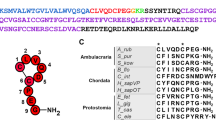Abstract
Present-day marsupials, which are supposed to have arisen from a single stem diverging from the placental stem some 130 million years ago, exist only in the American and Australian continents. Comparison of the homologous genes and their protein products, which evolved under different environmental conditions, may provide arguments for either selective or neutral evolution. In contrast to Australian Macropodidae, which have pecuIiar neurohypophysial peptides, namely mesotocin and two pressor peptides, lysine vasopressin and phenypressin, the South American oppossum,Didelpbis marsupialis, has oxytocin, lysine vasopressin, and arginine vasopressin. Because placental mammals have oxytocin and usually arginine vasopressin, and nonmammalian tetrapods have mesotocin and arginine vasotocin, it is assumed that (1) selective change of arginine vasotocin into arginine vasopressin occurred in mammalian ancestors and a subsequent gene duplication in the marsupial line gave rise to two pressor peptides with divergent neutral drifts in American and Australian groups, and (2) mesotocin of nonmammalian tetrapods has been preserved in Australian marsupials and reclaimed for milk-ejecting function whereas it has been converted into oxytocin in South American oppossums. The change of mesotocin into oxytocin seems neutral rather than selective.
Similar content being viewed by others
References
Romer AS (1966) Vertebrate Paleontology, University of Chicago Press, Chicago.
Acher R (1980) Proc. R. Soc. London Ser. B210, 21–43.
Clemens WA (1977) in: The Biology of Marsupials (Stonehouse B & Gilmore D, eds), pp 51–68, University Park Press, Baltimore.
Chauvet MT, Hurpet D, Chauvet J & Acher R (1980) Nature (London)287, 640–642.
Chauvet MT, Hurpet D, Chauvet J & Acher R (1981) FEBS Lett.129, 120–122.
Hurpet D, Chauvet MT, Chauvet J & Acher R (1980) Biochem. Biophys. Res. Commun.95, 1585–1590.
Chauvet MT, Hurpet D, Chauvet J & Acher R (1983) Gen. Comp. Endocrinol.49, 63–72.
Hurpet D, Chauvet MT, Charvet J & Acher R (1982) Int. J. Peptide Protein Res.19, 366–371.
Acher R, Chauvet J & Chauvet MT (1973) Nature New Biol.244, 124–126.
Schmale H, Heinsohn S & Richter D (1983) EMBO J.2, 763–767.
Chauvet MT, Colne T, Hurpet D, Chauvet J & Acher R (1983) Gen. Comp. Endocrinol.51, in press.
Spackman DH, Stein WH & Moore S (1958) Anal. Chem.30, 1190–1206.
Acher R, Beaupain R, Chauvet J, Chauvet MT & Crepy D (1964) Gen. Comp. Endocrinol.4, 596–601.
Land H, Grez M, Ruppert S, Schmale H, Rehbein M, Richter D & Schütz G (1983) Nature302, 342–344.
Land H, Schütz G, Schmale H & Richter D (1982) Nature295, 299–303.
Foldi J, Cohen-Solal M, Valentin C, Blouquit Y, Hollan SR & Rosa J (1980) Europ. J. Biochem.109, 463–471.
Popenoe EA, Lawler HC & du Vigneaud V (1952) J. Amer. Chem. Soc.74, 3713–3714.
Stewart AD (1971) J. Endocrinol.51, 191–201.
Ferguson DR (1969) Gen. Comp. Endocrinol.12, 609–613.
Kimura M (1968) Nature (London)217, 624–626.
Author information
Authors and Affiliations
Rights and permissions
About this article
Cite this article
Chauvet, J., Hurpet, D., Chauvet, M.T. et al. Divergent neuropeptide evolutionary drifts between American and Australian marsupials. Biosci Rep 4, 245–252 (1984). https://doi.org/10.1007/BF01119660
Received:
Issue Date:
DOI: https://doi.org/10.1007/BF01119660




